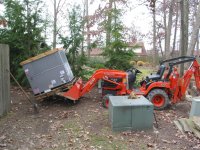O.K. we old timers go through this issue every couple of years when most of one group moves on and another group joins up.
There are two different specs for the 3ph (and I'm not talking about force vectoring/leverage factor which decreases the amount you can lift as you get farther from the hitch). One spec is the actual true lift ability and the other is the weight listed in the manual by a whole bunch of different implements. If you look carefully, you'll see those are all implements you use while the tractor is moving.
Here's the problem. Your mischievous nephew from the city comes to visit and decides to joy ride your tractor. Your brush hog is on the back and the brat decides to race across your freshly furrowed field, perpendicular to the furrows. If your brush hog weighs the absolute max the 3ph can lift, the oscillation (abusive bouncing) is gonna break a joint or pulse the hydraulic fluid enough to blow a cylinder.
Implements that you use while in motion are given a max weight which allows a safety margin for this bouncing effect. You can lift heavier attachments than the weights listed, but if you do, then you abuse the tractor and something breaks due to that, Kubota can justifiably say you voided the warranty as well as injury liability by going over the spec'ed weight. Now a
chipper, generator, log splitter, etc. are used while the tractor sits still. That's why they don't put weight limits on those attachments. You just go by the max lifting capacity. If the 3ph lifts it, fine. You just drive carefully to your job spot, lower the implement, and there's no bouncing that's going to damage the 3ph or hydraulics while the tractor sits still and the engine powers the stationary attachment.
So, you don't have to go by what the manual says for implement maximums. If you're a few pounds over, and you don't try to push the thing to the limit like a test pilot, there's probably not going to be a problem. Just use common sense!

